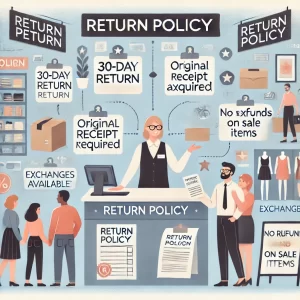
Shopping online has become a cornerstone of modern retail, offering unparalleled convenience and variety. However, one area that often generates confusion and anxiety for consumers is the return policy. Understanding these policies is crucial for a smooth shopping experience, as it directly impacts your ability to return items and obtain refunds. This article will delve into the importance of understanding return policies, outline their essential elements, and provide practical tips for navigating them effectively.
Importance of Understanding Return Policies
Building Consumer Confidence
When you shop online, you can only physically inspect the items after purchasing. This inherent uncertainty makes understanding return policies critical. A clear, customer-friendly return policy can significantly boost consumer confidence. Knowing that you can return an item that doesn’t meet your expectations allows you to shop with a sense of security. Brands prioritizing transparent return policies often see higher customer retention and loyalty rates.
Avoiding Frustration
Unfavorable return policies can lead to frustration, especially if you receive a product that doesn’t match its description or arrives damaged. Many consumers have faced the hassle of dealing with complicated return processes, which can discourage future purchases from the same retailer. By familiarizing yourself with return policies, you can avoid these pitfalls and make informed decisions that align with your shopping preferences.
Encouraging Informed Purchases
Understanding return policies helps you assess the risk of purchasing a particular product. For example, if a store offers a 30-day return window for full refunds, you can feel more secure trying out new products. In contrast, a store that only offers exchanges or has strict return deadlines may prompt you to reconsider purchasing.
Building Trust with Retailers
Retailers that openly communicate their return policies often foster a sense of trust with their customers. Transparency regarding return procedures, timelines, and potential costs builds rapport, encouraging repeat business. In an era of fierce competition, having a customer-friendly return policy can distinguish a retailer from its competitors.
Key Elements of Online Return Policies
 Understanding the critical elements of return policies can help you navigate the shopping process more efficiently. Here are the essential components you should look for when reviewing a retailer’s return policy:
Understanding the critical elements of return policies can help you navigate the shopping process more efficiently. Here are the essential components you should look for when reviewing a retailer’s return policy:
Eligibility Criteria
Most return policies outline specific conditions determining whether you can return an item. Common eligibility criteria include:
- Timeframe: Many retailers require returns to be initiated within specific days from the date of purchase or delivery. Typical windows range from 14 to 90 days.
- Condition of the Item: Items must often be returned in their original condition, which usually means they should be unused, unopened, and accompanied by all original packaging and accessories.
- Proof of Purchase: Most retailers require a receipt or order confirmation email to process a return. This is essential for verifying the transaction and establishing eligibility for a refund.
Return Process
The return process can vary significantly between retailers, but it generally involves the following steps:
- Initiating the Return: Customers must usually contact customer service, fill out a return request form, or log into their account to initiate the return.
- Obtaining a Return Authorization: Some retailers may require a return authorization number to track the return process. Place this number inside the return package.
- Packaging and Shipping: Customers are responsible for securely packaging and shipping the item back, often at their own expense, unless the retailer specifies otherwise.
Refund Methods
Refund methods clarify how you will receive your money back after a return. Common options include:
- Refund to Original Payment Method: The most straightforward method is to issue the refund back to the card or account used for the original purchase.
- Store Credit: Some retailers offer store credit instead of a direct refund, which can be advantageous if you plan to make a future purchase.
- Exchanges: Some policies allow customers to exchange the returned item for a different product, which may be a convenient option if you still want something from the retailer.
Exceptions and Exclusions
Most return policies include exceptions and exclusions that customers must be aware of. These might include:
- Final Sale Items: Items marked as final sale are usually not eligible for return, typically for clearance items, personalized products, or certain beauty products.
- Non-Returnable Items: Many retailers have specific categories of items that cannot be returned, such as opened electronics, intimate apparel, or digital downloads.
Return Shipping and Fees
Understanding the shipping costs associated with returns is essential. Retailers may have different policies regarding return shipping:
- Free Returns: Some retailers offer free return shipping as customer service. This can greatly improve the overall shopping experience.
- Customer-Paid Shipping: Other retailers may require customers to cover the cost of return shipping. Be sure to factor this into your overall cost when considering a purchase.
Restocking Fees
Some retailers impose restocking fees for returned items, which can be deducted from your total refund amount. This fee is more common for larger items, like furniture or electronics, so reviewing this policy aspect is essential.
- Common Scenarios: Restocking fees are more prevalent for larger items, such as furniture or electronics, where the costs associated with returns can be substantial. Retailers may charge these fees to cover operational expenses related to inspecting, refurbishing, or repackaging returned items.
- Condition of Returned Items: The item’s condition upon return can significantly impact whether a restocking fee applies. For example, if an item is returned opened, used, or damaged, the retailer may impose a higher cost or, in some cases, refuse the return altogether.
- Exemptions: Some retailers waive restocking fees for specific items or during promotional periods. It’s worth checking if particular categories, like seasonal items or merchandise bought during sales events, have different return conditions.
Communication Channels
Effective communication is vital when navigating return policies. Retailers may offer various channels for customers to seek assistance, including:
- Customer Support: Most retailers provide a dedicated customer support team that can help answer questions about return policies, processes, and any issues that may arise.
- Live Chat Options: Many eCommerce sites now offer live chat functionality, allowing customers to get real-time responses to their queries, which can speed up the return process.
- FAQs and Online Resources: Retailers often maintain a FAQ section or resource page outlining their return policies. Familiarizing yourself with these resources can save you time and frustration.
International Returns
If you’re shopping from a retailer located in another country, it’s crucial to understand their international return policies:
- Shipping Costs: International returns can be more complex and costly. Depending on the retailer’s policies, customers may be responsible for return shipping fees, which can be significant.
- Customs Duties and Taxes: In some cases, customers might face customs duties or taxes on returned items, which can affect the total cost of the return. Understanding these implications beforehand can help you avoid unexpected charges.
- Extended Return Periods: Some retailers offer extended return periods for international orders to account for longer shipping times. Always check the specific policies before completing your purchase.
Seasonal and Promotional Returns
Be aware that return policies may differ during specific promotional events or holiday seasons:
- Holiday Returns: Many retailers extend their return periods during the holiday season, allowing customers to return gifts more easily. This is especially common for items purchased in November and December.
- Clearance and Sale Items: Some retailers may have stricter return policies for items purchased on sale or during clearance events. Always read the fine print to avoid surprises when returning discounted products.
Tracking Your Return
After initiating a return, it’s essential to track its progress to ensure you receive your refund promptly:
- Return Tracking: If you’ve shipped your return, most retailers provide tracking numbers to monitor its status. Keeping an eye on this can help you verify that the retailer has received the item.
- Follow-Up: If you have not received confirmation of your refund within the expected timeframe, please follow up with customer support. Having your tracking information and order details on hand can expedite this process.
- Monitoring Communication: Be attentive to emails or notifications from the retailer regarding your return. Many retailers will send confirmations when they receive your returned item and when your refund has been processed.
Tips for Navigating Return Policies Effectively
Navigating return policies can be complex, but these practical tips can make the process smoother and less stressful:
- Read the Return Policy Before Purchasing: Always take the time to read and understand the return policy before finalizing your purchase. This can prevent surprises later and help you make more informed decisions.
- Document Important Information: Record important information, such as order numbers, receipt details, and return deadlines. This documentation will be invaluable if you need to initiate a return.
- Communicate with Customer Support: If you’re unsure about specific aspects of a return policy, don’t hesitate to contact customer support for clarification. They can help explain the process and provide insights tailored to your situation.
- Follow the Return Process Carefully: Each retailer has its return process; following it closely is crucial for a triumphant return. Ensure you obtain any necessary return authorization and include it with the returned item.
- Provide Required Documentation: When initiating a return, be prepared to provide necessary documentation, such as proof of purchase and any return forms. Having this information handy can speed up the process.
- Monitor the Return Process: After you’ve initiated a return, keep track of its progress. This includes monitoring shipping status and following up with customer support if there are delays or issues.
- Keep an Eye on Refund Timelines: Be aware of the estimated refund timeframe, which can vary between retailers. This will help manage your expectations regarding when to expect your money back.
- Understand the Appeals Process: In cases where a return request is denied or there is a dispute over the refund amount, know how to appeal the decision. Familiarize yourself with the escalation process for resolving disputes.
- Shop with Retailers Known for Their Policies: Some retailers are recognized for their customer-friendly return policies. Consider shopping with these brands to enhance your shopping experience.
Conclusion
Understanding return policies is essential for online shopping, as it boosts consumer confidence and encourages more freedom in purchasing. By familiarizing yourself with key aspects of these policies and following the tips in this article, you can enhance your shopping experience and know what to expect when returning items. In today’s competitive eCommerce landscape, transparent return policies are crucial for customer satisfaction and fostering long-term relationships. So, the next time you shop online, take a moment to review the return policies to improve your overall experience.







